PUBH 6006: Community Health, Disease Prevention & Health Promotion
VerifiedAdded on 2023/04/10
|12
|2465
|401
Essay
AI Summary
This essay delves into community health and disease prevention, focusing on hypertension as a case study. It uses Laverack’s Ladder of community-based interaction as a framework to address hypertension through medical, socio-ecological, and behavioral strategies. The essay emphasizes the importance of community engagement, capacity building, and the health benefits model in promoting sustainable prevention programs. It highlights the need for awareness, lifestyle changes, and addressing barriers to healthcare to improve community health outcomes. The role of external agencies and community members in intervention programs is also discussed, emphasizing the empowerment and ownership that lead to effective health development processes. Desklib offers a wealth of similar resources for students.
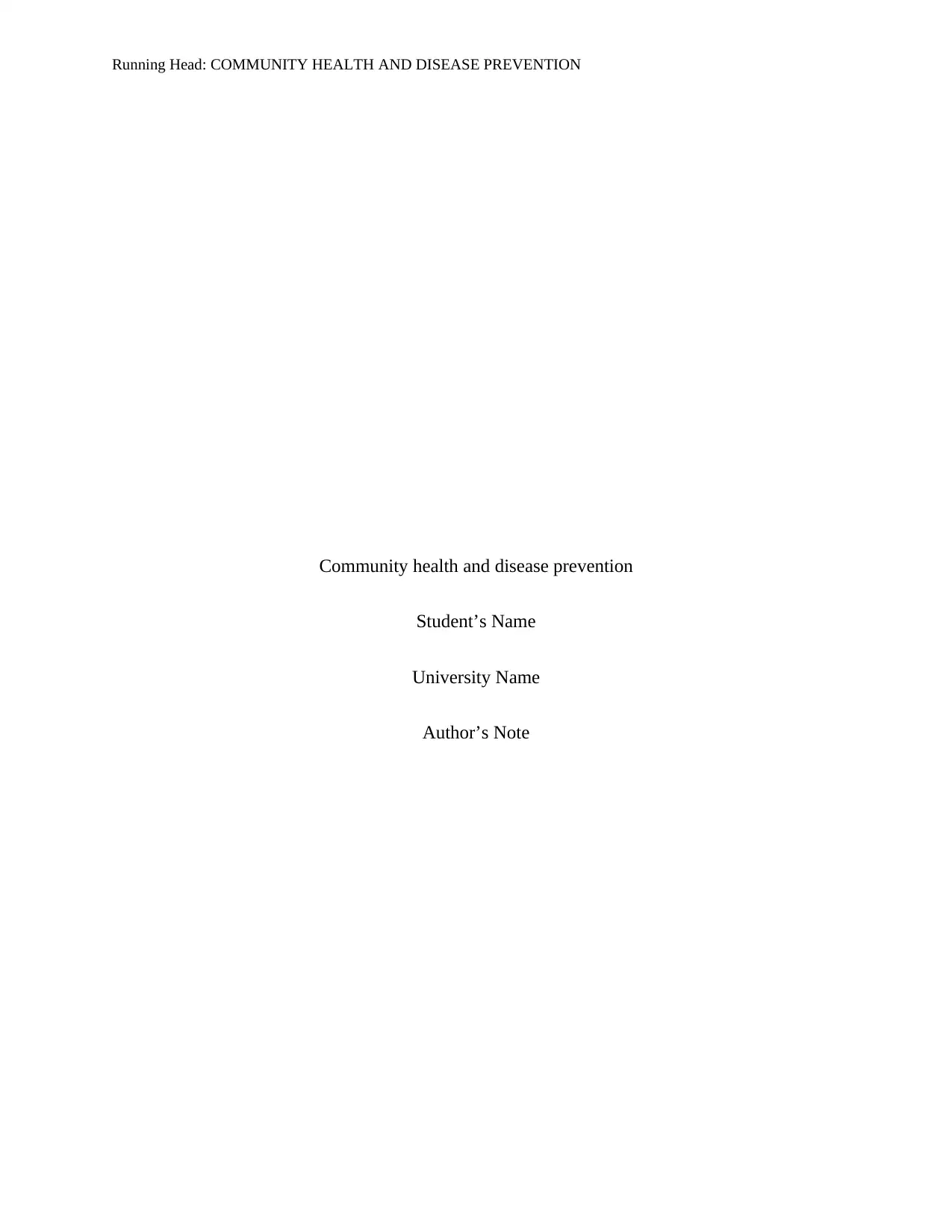
Running Head: COMMUNITY HEALTH AND DISEASE PREVENTION
Community health and disease prevention
Student’s Name
University Name
Author’s Note
Community health and disease prevention
Student’s Name
University Name
Author’s Note
Paraphrase This Document
Need a fresh take? Get an instant paraphrase of this document with our AI Paraphraser
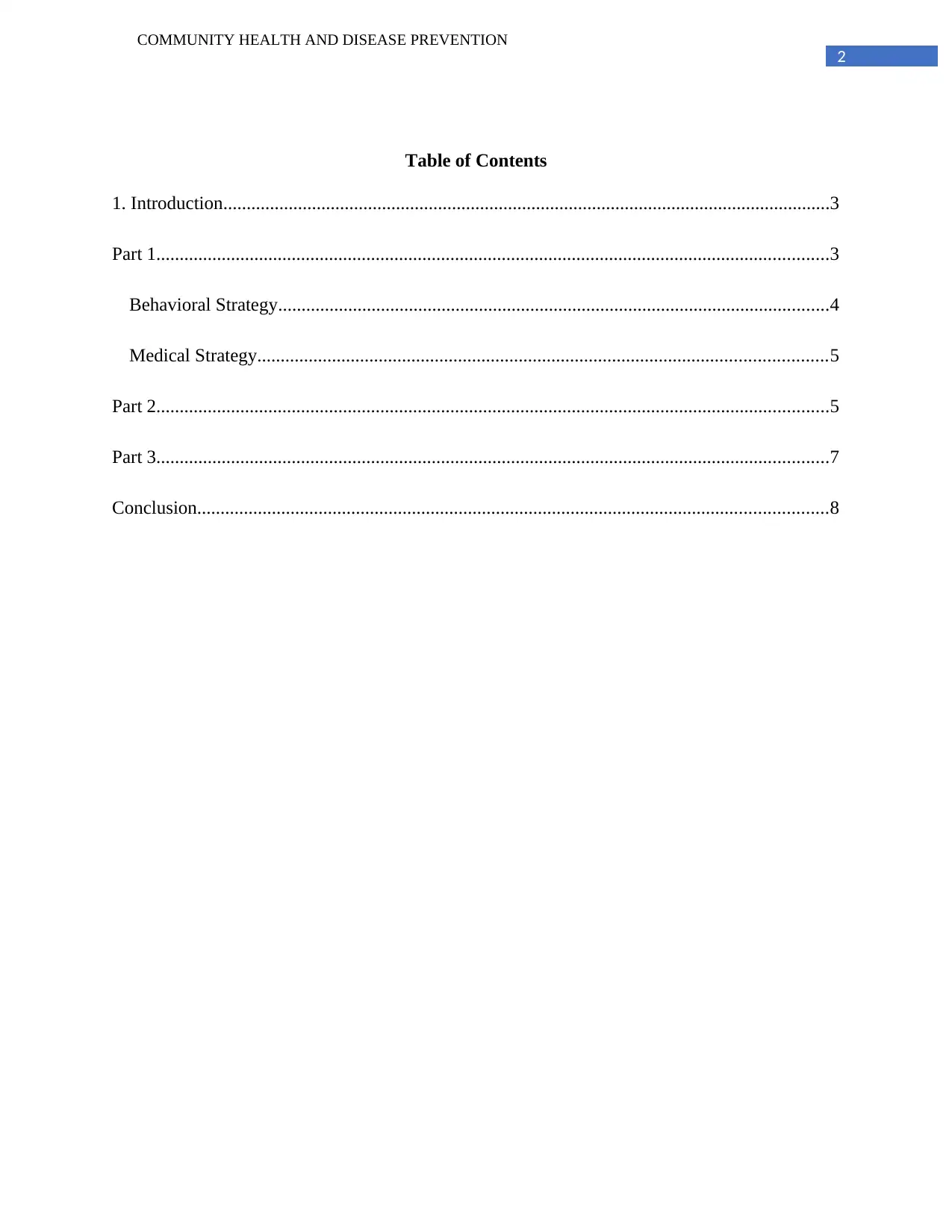
2
COMMUNITY HEALTH AND DISEASE PREVENTION
Table of Contents
1. Introduction..................................................................................................................................3
Part 1................................................................................................................................................3
Behavioral Strategy......................................................................................................................4
Medical Strategy..........................................................................................................................5
Part 2................................................................................................................................................5
Part 3................................................................................................................................................7
Conclusion.......................................................................................................................................8
COMMUNITY HEALTH AND DISEASE PREVENTION
Table of Contents
1. Introduction..................................................................................................................................3
Part 1................................................................................................................................................3
Behavioral Strategy......................................................................................................................4
Medical Strategy..........................................................................................................................5
Part 2................................................................................................................................................5
Part 3................................................................................................................................................7
Conclusion.......................................................................................................................................8
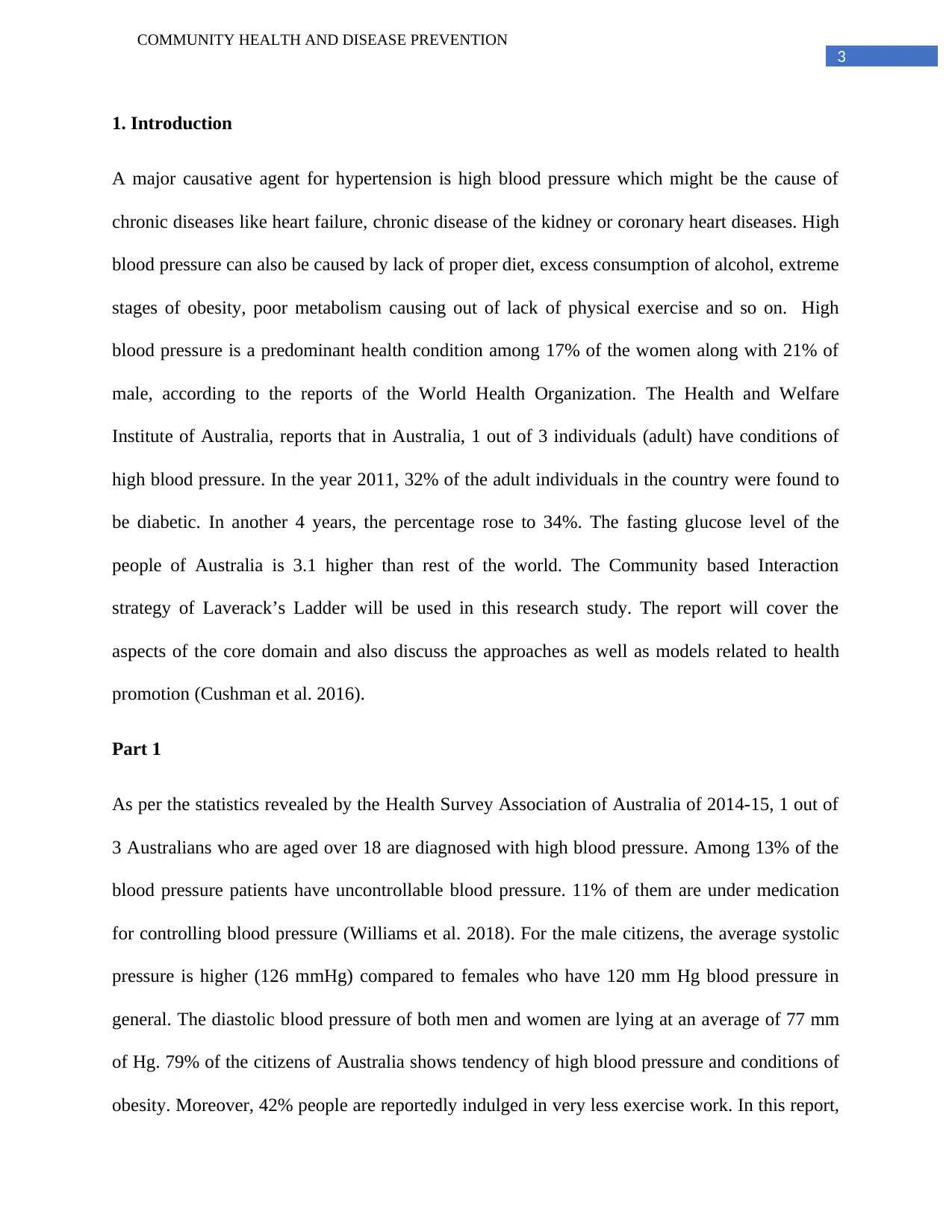
3
COMMUNITY HEALTH AND DISEASE PREVENTION
1. Introduction
A major causative agent for hypertension is high blood pressure which might be the cause of
chronic diseases like heart failure, chronic disease of the kidney or coronary heart diseases. High
blood pressure can also be caused by lack of proper diet, excess consumption of alcohol, extreme
stages of obesity, poor metabolism causing out of lack of physical exercise and so on. High
blood pressure is a predominant health condition among 17% of the women along with 21% of
male, according to the reports of the World Health Organization. The Health and Welfare
Institute of Australia, reports that in Australia, 1 out of 3 individuals (adult) have conditions of
high blood pressure. In the year 2011, 32% of the adult individuals in the country were found to
be diabetic. In another 4 years, the percentage rose to 34%. The fasting glucose level of the
people of Australia is 3.1 higher than rest of the world. The Community based Interaction
strategy of Laverack’s Ladder will be used in this research study. The report will cover the
aspects of the core domain and also discuss the approaches as well as models related to health
promotion (Cushman et al. 2016).
Part 1
As per the statistics revealed by the Health Survey Association of Australia of 2014-15, 1 out of
3 Australians who are aged over 18 are diagnosed with high blood pressure. Among 13% of the
blood pressure patients have uncontrollable blood pressure. 11% of them are under medication
for controlling blood pressure (Williams et al. 2018). For the male citizens, the average systolic
pressure is higher (126 mmHg) compared to females who have 120 mm Hg blood pressure in
general. The diastolic blood pressure of both men and women are lying at an average of 77 mm
of Hg. 79% of the citizens of Australia shows tendency of high blood pressure and conditions of
obesity. Moreover, 42% people are reportedly indulged in very less exercise work. In this report,
COMMUNITY HEALTH AND DISEASE PREVENTION
1. Introduction
A major causative agent for hypertension is high blood pressure which might be the cause of
chronic diseases like heart failure, chronic disease of the kidney or coronary heart diseases. High
blood pressure can also be caused by lack of proper diet, excess consumption of alcohol, extreme
stages of obesity, poor metabolism causing out of lack of physical exercise and so on. High
blood pressure is a predominant health condition among 17% of the women along with 21% of
male, according to the reports of the World Health Organization. The Health and Welfare
Institute of Australia, reports that in Australia, 1 out of 3 individuals (adult) have conditions of
high blood pressure. In the year 2011, 32% of the adult individuals in the country were found to
be diabetic. In another 4 years, the percentage rose to 34%. The fasting glucose level of the
people of Australia is 3.1 higher than rest of the world. The Community based Interaction
strategy of Laverack’s Ladder will be used in this research study. The report will cover the
aspects of the core domain and also discuss the approaches as well as models related to health
promotion (Cushman et al. 2016).
Part 1
As per the statistics revealed by the Health Survey Association of Australia of 2014-15, 1 out of
3 Australians who are aged over 18 are diagnosed with high blood pressure. Among 13% of the
blood pressure patients have uncontrollable blood pressure. 11% of them are under medication
for controlling blood pressure (Williams et al. 2018). For the male citizens, the average systolic
pressure is higher (126 mmHg) compared to females who have 120 mm Hg blood pressure in
general. The diastolic blood pressure of both men and women are lying at an average of 77 mm
of Hg. 79% of the citizens of Australia shows tendency of high blood pressure and conditions of
obesity. Moreover, 42% people are reportedly indulged in very less exercise work. In this report,
⊘ This is a preview!⊘
Do you want full access?
Subscribe today to unlock all pages.

Trusted by 1+ million students worldwide
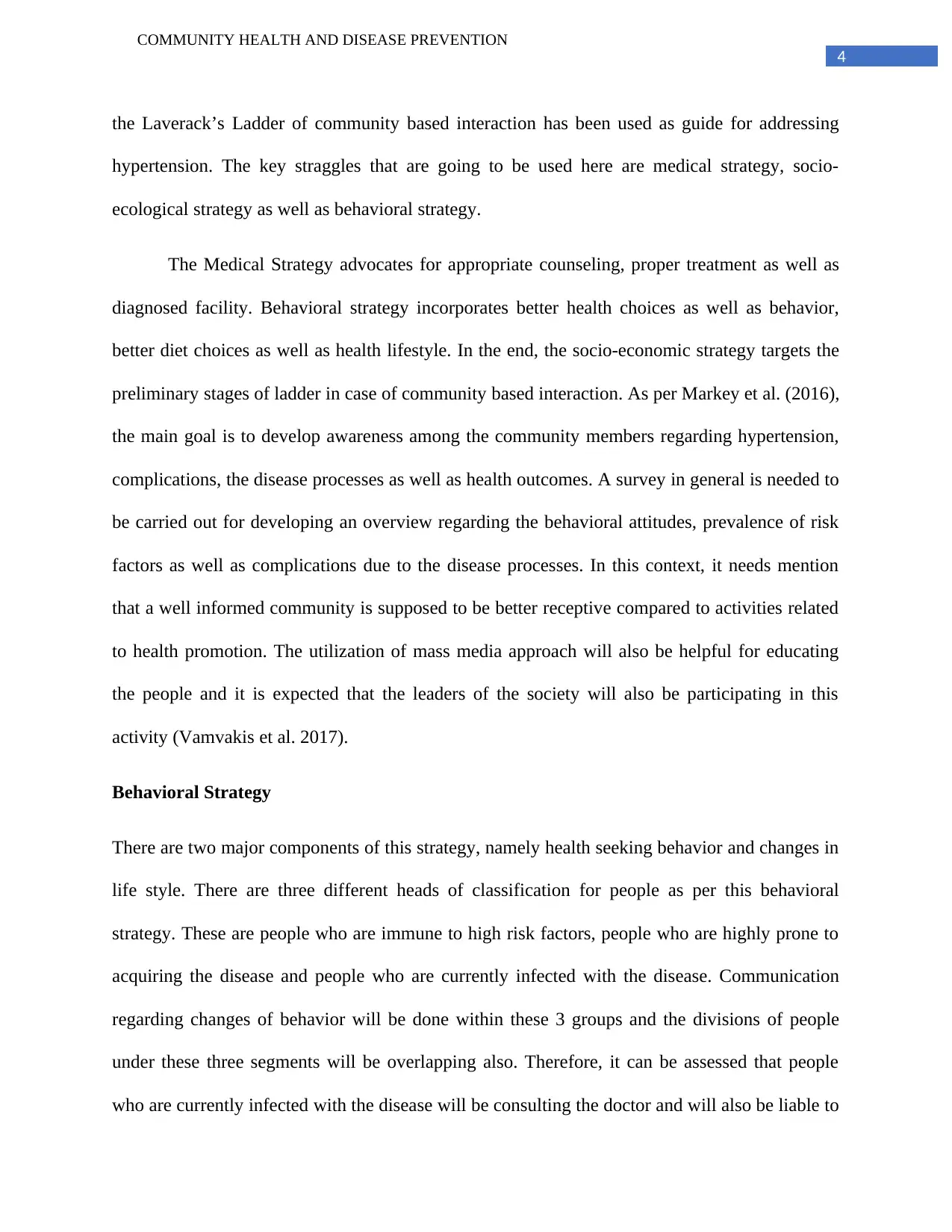
4
COMMUNITY HEALTH AND DISEASE PREVENTION
the Laverack’s Ladder of community based interaction has been used as guide for addressing
hypertension. The key straggles that are going to be used here are medical strategy, socio-
ecological strategy as well as behavioral strategy.
The Medical Strategy advocates for appropriate counseling, proper treatment as well as
diagnosed facility. Behavioral strategy incorporates better health choices as well as behavior,
better diet choices as well as health lifestyle. In the end, the socio-economic strategy targets the
preliminary stages of ladder in case of community based interaction. As per Markey et al. (2016),
the main goal is to develop awareness among the community members regarding hypertension,
complications, the disease processes as well as health outcomes. A survey in general is needed to
be carried out for developing an overview regarding the behavioral attitudes, prevalence of risk
factors as well as complications due to the disease processes. In this context, it needs mention
that a well informed community is supposed to be better receptive compared to activities related
to health promotion. The utilization of mass media approach will also be helpful for educating
the people and it is expected that the leaders of the society will also be participating in this
activity (Vamvakis et al. 2017).
Behavioral Strategy
There are two major components of this strategy, namely health seeking behavior and changes in
life style. There are three different heads of classification for people as per this behavioral
strategy. These are people who are immune to high risk factors, people who are highly prone to
acquiring the disease and people who are currently infected with the disease. Communication
regarding changes of behavior will be done within these 3 groups and the divisions of people
under these three segments will be overlapping also. Therefore, it can be assessed that people
who are currently infected with the disease will be consulting the doctor and will also be liable to
COMMUNITY HEALTH AND DISEASE PREVENTION
the Laverack’s Ladder of community based interaction has been used as guide for addressing
hypertension. The key straggles that are going to be used here are medical strategy, socio-
ecological strategy as well as behavioral strategy.
The Medical Strategy advocates for appropriate counseling, proper treatment as well as
diagnosed facility. Behavioral strategy incorporates better health choices as well as behavior,
better diet choices as well as health lifestyle. In the end, the socio-economic strategy targets the
preliminary stages of ladder in case of community based interaction. As per Markey et al. (2016),
the main goal is to develop awareness among the community members regarding hypertension,
complications, the disease processes as well as health outcomes. A survey in general is needed to
be carried out for developing an overview regarding the behavioral attitudes, prevalence of risk
factors as well as complications due to the disease processes. In this context, it needs mention
that a well informed community is supposed to be better receptive compared to activities related
to health promotion. The utilization of mass media approach will also be helpful for educating
the people and it is expected that the leaders of the society will also be participating in this
activity (Vamvakis et al. 2017).
Behavioral Strategy
There are two major components of this strategy, namely health seeking behavior and changes in
life style. There are three different heads of classification for people as per this behavioral
strategy. These are people who are immune to high risk factors, people who are highly prone to
acquiring the disease and people who are currently infected with the disease. Communication
regarding changes of behavior will be done within these 3 groups and the divisions of people
under these three segments will be overlapping also. Therefore, it can be assessed that people
who are currently infected with the disease will be consulting the doctor and will also be liable to
Paraphrase This Document
Need a fresh take? Get an instant paraphrase of this document with our AI Paraphraser
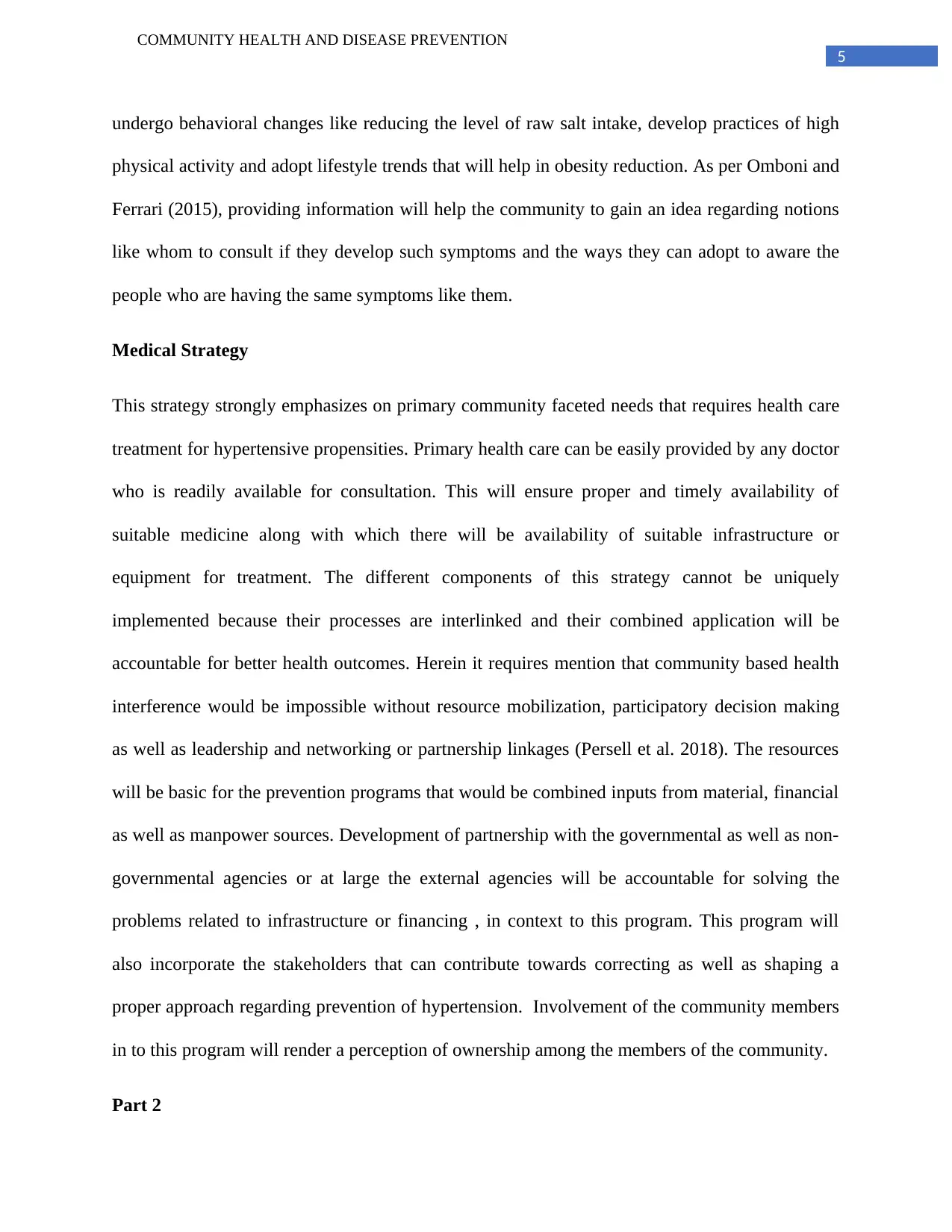
5
COMMUNITY HEALTH AND DISEASE PREVENTION
undergo behavioral changes like reducing the level of raw salt intake, develop practices of high
physical activity and adopt lifestyle trends that will help in obesity reduction. As per Omboni and
Ferrari (2015), providing information will help the community to gain an idea regarding notions
like whom to consult if they develop such symptoms and the ways they can adopt to aware the
people who are having the same symptoms like them.
Medical Strategy
This strategy strongly emphasizes on primary community faceted needs that requires health care
treatment for hypertensive propensities. Primary health care can be easily provided by any doctor
who is readily available for consultation. This will ensure proper and timely availability of
suitable medicine along with which there will be availability of suitable infrastructure or
equipment for treatment. The different components of this strategy cannot be uniquely
implemented because their processes are interlinked and their combined application will be
accountable for better health outcomes. Herein it requires mention that community based health
interference would be impossible without resource mobilization, participatory decision making
as well as leadership and networking or partnership linkages (Persell et al. 2018). The resources
will be basic for the prevention programs that would be combined inputs from material, financial
as well as manpower sources. Development of partnership with the governmental as well as non-
governmental agencies or at large the external agencies will be accountable for solving the
problems related to infrastructure or financing , in context to this program. This program will
also incorporate the stakeholders that can contribute towards correcting as well as shaping a
proper approach regarding prevention of hypertension. Involvement of the community members
in to this program will render a perception of ownership among the members of the community.
Part 2
COMMUNITY HEALTH AND DISEASE PREVENTION
undergo behavioral changes like reducing the level of raw salt intake, develop practices of high
physical activity and adopt lifestyle trends that will help in obesity reduction. As per Omboni and
Ferrari (2015), providing information will help the community to gain an idea regarding notions
like whom to consult if they develop such symptoms and the ways they can adopt to aware the
people who are having the same symptoms like them.
Medical Strategy
This strategy strongly emphasizes on primary community faceted needs that requires health care
treatment for hypertensive propensities. Primary health care can be easily provided by any doctor
who is readily available for consultation. This will ensure proper and timely availability of
suitable medicine along with which there will be availability of suitable infrastructure or
equipment for treatment. The different components of this strategy cannot be uniquely
implemented because their processes are interlinked and their combined application will be
accountable for better health outcomes. Herein it requires mention that community based health
interference would be impossible without resource mobilization, participatory decision making
as well as leadership and networking or partnership linkages (Persell et al. 2018). The resources
will be basic for the prevention programs that would be combined inputs from material, financial
as well as manpower sources. Development of partnership with the governmental as well as non-
governmental agencies or at large the external agencies will be accountable for solving the
problems related to infrastructure or financing , in context to this program. This program will
also incorporate the stakeholders that can contribute towards correcting as well as shaping a
proper approach regarding prevention of hypertension. Involvement of the community members
in to this program will render a perception of ownership among the members of the community.
Part 2
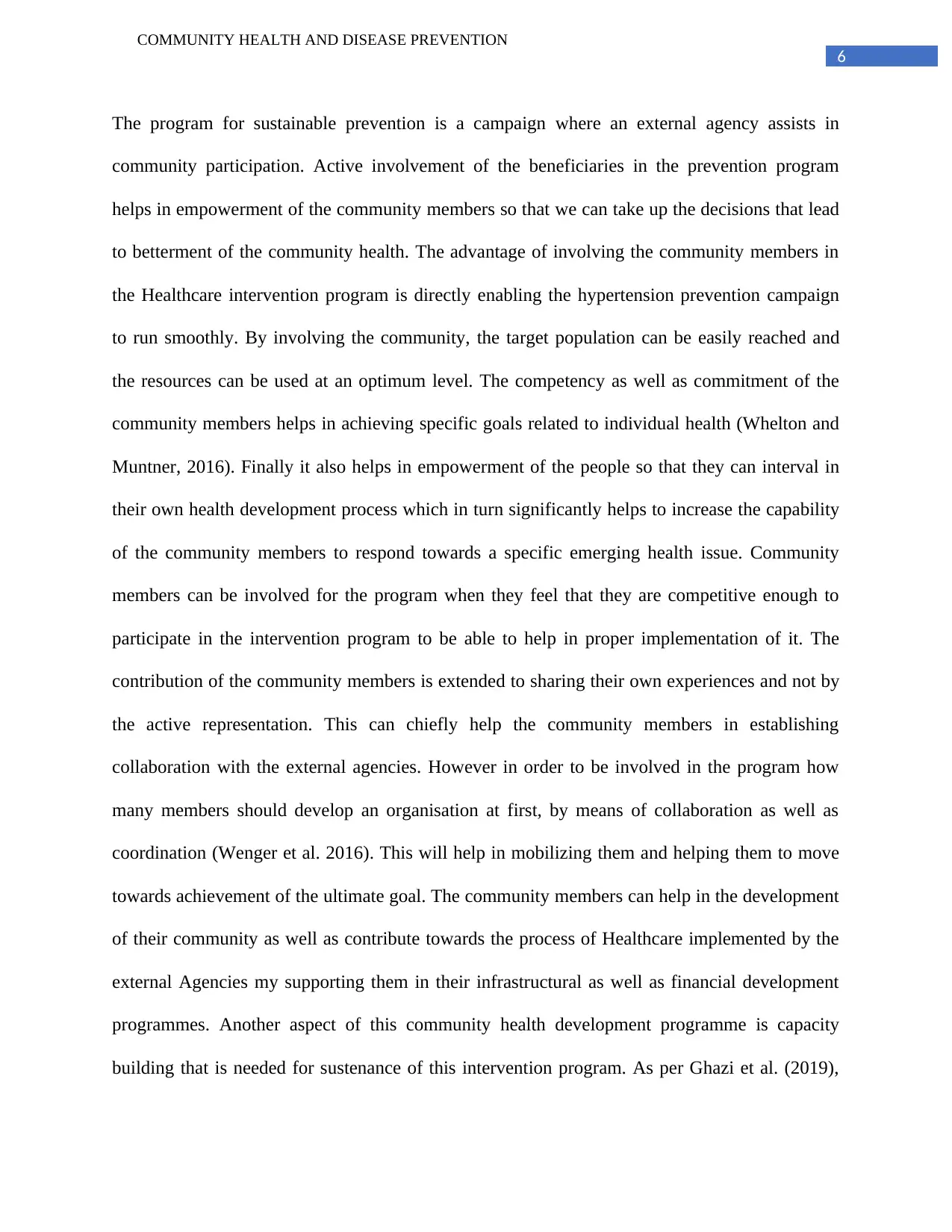
6
COMMUNITY HEALTH AND DISEASE PREVENTION
The program for sustainable prevention is a campaign where an external agency assists in
community participation. Active involvement of the beneficiaries in the prevention program
helps in empowerment of the community members so that we can take up the decisions that lead
to betterment of the community health. The advantage of involving the community members in
the Healthcare intervention program is directly enabling the hypertension prevention campaign
to run smoothly. By involving the community, the target population can be easily reached and
the resources can be used at an optimum level. The competency as well as commitment of the
community members helps in achieving specific goals related to individual health (Whelton and
Muntner, 2016). Finally it also helps in empowerment of the people so that they can interval in
their own health development process which in turn significantly helps to increase the capability
of the community members to respond towards a specific emerging health issue. Community
members can be involved for the program when they feel that they are competitive enough to
participate in the intervention program to be able to help in proper implementation of it. The
contribution of the community members is extended to sharing their own experiences and not by
the active representation. This can chiefly help the community members in establishing
collaboration with the external agencies. However in order to be involved in the program how
many members should develop an organisation at first, by means of collaboration as well as
coordination (Wenger et al. 2016). This will help in mobilizing them and helping them to move
towards achievement of the ultimate goal. The community members can help in the development
of their community as well as contribute towards the process of Healthcare implemented by the
external Agencies my supporting them in their infrastructural as well as financial development
programmes. Another aspect of this community health development programme is capacity
building that is needed for sustenance of this intervention program. As per Ghazi et al. (2019),
COMMUNITY HEALTH AND DISEASE PREVENTION
The program for sustainable prevention is a campaign where an external agency assists in
community participation. Active involvement of the beneficiaries in the prevention program
helps in empowerment of the community members so that we can take up the decisions that lead
to betterment of the community health. The advantage of involving the community members in
the Healthcare intervention program is directly enabling the hypertension prevention campaign
to run smoothly. By involving the community, the target population can be easily reached and
the resources can be used at an optimum level. The competency as well as commitment of the
community members helps in achieving specific goals related to individual health (Whelton and
Muntner, 2016). Finally it also helps in empowerment of the people so that they can interval in
their own health development process which in turn significantly helps to increase the capability
of the community members to respond towards a specific emerging health issue. Community
members can be involved for the program when they feel that they are competitive enough to
participate in the intervention program to be able to help in proper implementation of it. The
contribution of the community members is extended to sharing their own experiences and not by
the active representation. This can chiefly help the community members in establishing
collaboration with the external agencies. However in order to be involved in the program how
many members should develop an organisation at first, by means of collaboration as well as
coordination (Wenger et al. 2016). This will help in mobilizing them and helping them to move
towards achievement of the ultimate goal. The community members can help in the development
of their community as well as contribute towards the process of Healthcare implemented by the
external Agencies my supporting them in their infrastructural as well as financial development
programmes. Another aspect of this community health development programme is capacity
building that is needed for sustenance of this intervention program. As per Ghazi et al. (2019),
⊘ This is a preview!⊘
Do you want full access?
Subscribe today to unlock all pages.

Trusted by 1+ million students worldwide
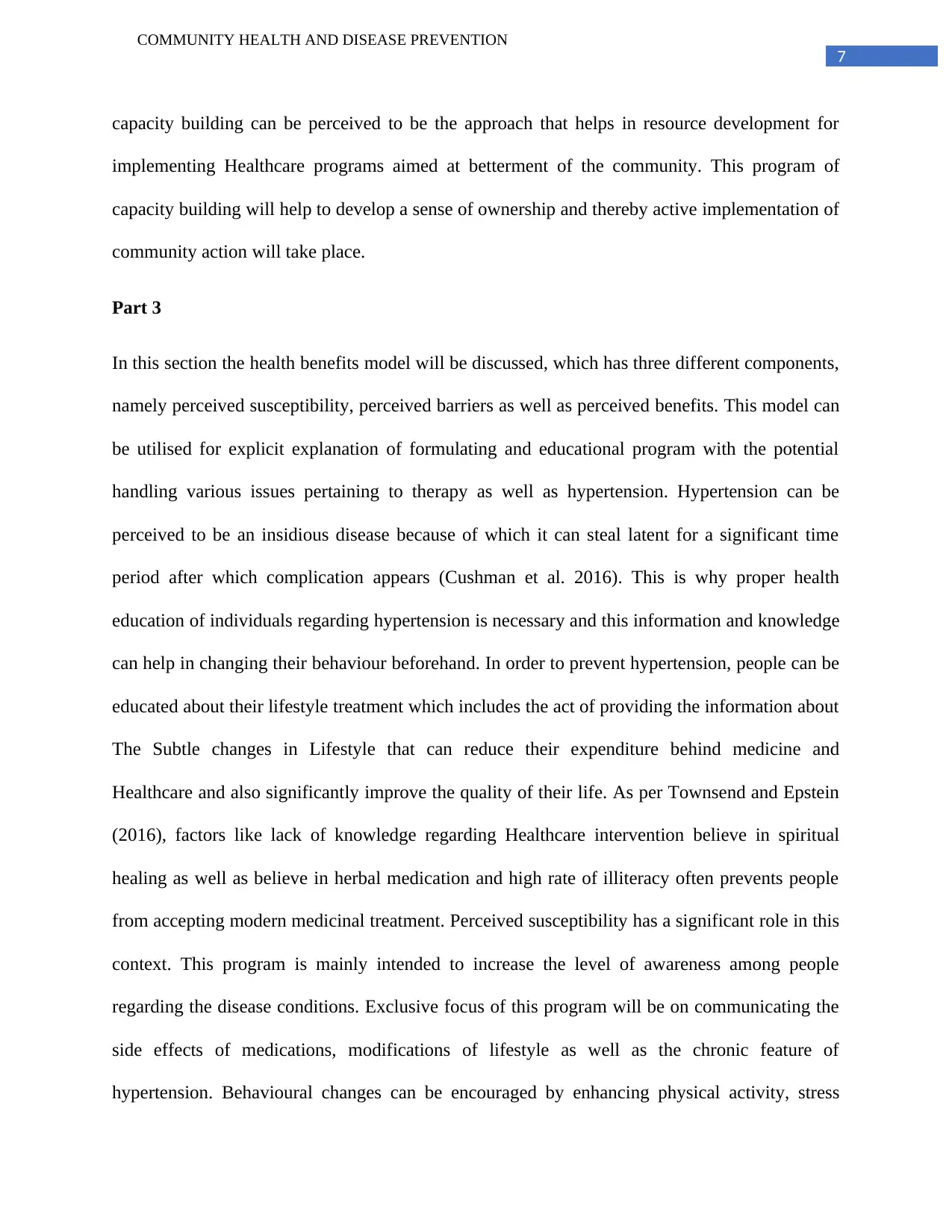
7
COMMUNITY HEALTH AND DISEASE PREVENTION
capacity building can be perceived to be the approach that helps in resource development for
implementing Healthcare programs aimed at betterment of the community. This program of
capacity building will help to develop a sense of ownership and thereby active implementation of
community action will take place.
Part 3
In this section the health benefits model will be discussed, which has three different components,
namely perceived susceptibility, perceived barriers as well as perceived benefits. This model can
be utilised for explicit explanation of formulating and educational program with the potential
handling various issues pertaining to therapy as well as hypertension. Hypertension can be
perceived to be an insidious disease because of which it can steal latent for a significant time
period after which complication appears (Cushman et al. 2016). This is why proper health
education of individuals regarding hypertension is necessary and this information and knowledge
can help in changing their behaviour beforehand. In order to prevent hypertension, people can be
educated about their lifestyle treatment which includes the act of providing the information about
The Subtle changes in Lifestyle that can reduce their expenditure behind medicine and
Healthcare and also significantly improve the quality of their life. As per Townsend and Epstein
(2016), factors like lack of knowledge regarding Healthcare intervention believe in spiritual
healing as well as believe in herbal medication and high rate of illiteracy often prevents people
from accepting modern medicinal treatment. Perceived susceptibility has a significant role in this
context. This program is mainly intended to increase the level of awareness among people
regarding the disease conditions. Exclusive focus of this program will be on communicating the
side effects of medications, modifications of lifestyle as well as the chronic feature of
hypertension. Behavioural changes can be encouraged by enhancing physical activity, stress
COMMUNITY HEALTH AND DISEASE PREVENTION
capacity building can be perceived to be the approach that helps in resource development for
implementing Healthcare programs aimed at betterment of the community. This program of
capacity building will help to develop a sense of ownership and thereby active implementation of
community action will take place.
Part 3
In this section the health benefits model will be discussed, which has three different components,
namely perceived susceptibility, perceived barriers as well as perceived benefits. This model can
be utilised for explicit explanation of formulating and educational program with the potential
handling various issues pertaining to therapy as well as hypertension. Hypertension can be
perceived to be an insidious disease because of which it can steal latent for a significant time
period after which complication appears (Cushman et al. 2016). This is why proper health
education of individuals regarding hypertension is necessary and this information and knowledge
can help in changing their behaviour beforehand. In order to prevent hypertension, people can be
educated about their lifestyle treatment which includes the act of providing the information about
The Subtle changes in Lifestyle that can reduce their expenditure behind medicine and
Healthcare and also significantly improve the quality of their life. As per Townsend and Epstein
(2016), factors like lack of knowledge regarding Healthcare intervention believe in spiritual
healing as well as believe in herbal medication and high rate of illiteracy often prevents people
from accepting modern medicinal treatment. Perceived susceptibility has a significant role in this
context. This program is mainly intended to increase the level of awareness among people
regarding the disease conditions. Exclusive focus of this program will be on communicating the
side effects of medications, modifications of lifestyle as well as the chronic feature of
hypertension. Behavioural changes can be encouraged by enhancing physical activity, stress
Paraphrase This Document
Need a fresh take? Get an instant paraphrase of this document with our AI Paraphraser
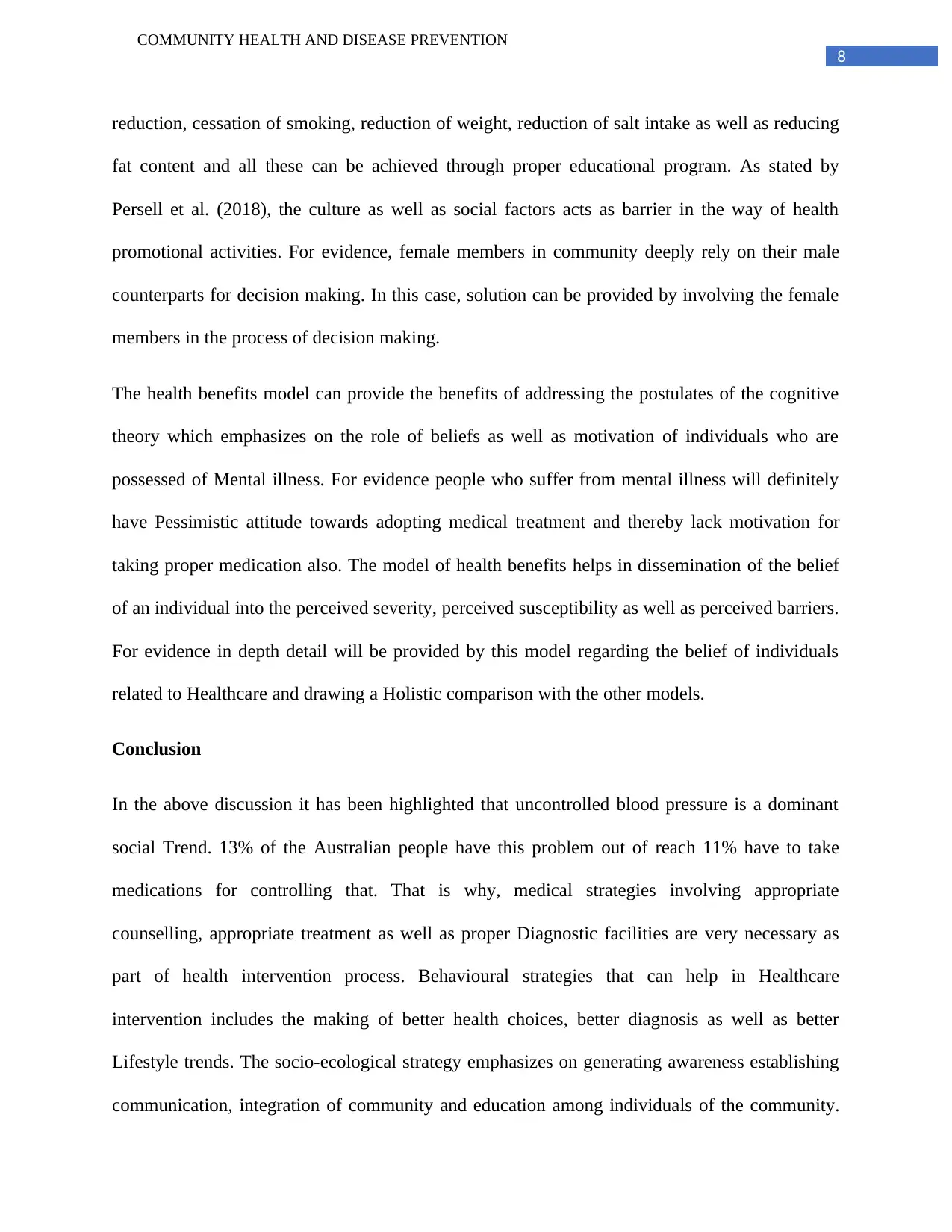
8
COMMUNITY HEALTH AND DISEASE PREVENTION
reduction, cessation of smoking, reduction of weight, reduction of salt intake as well as reducing
fat content and all these can be achieved through proper educational program. As stated by
Persell et al. (2018), the culture as well as social factors acts as barrier in the way of health
promotional activities. For evidence, female members in community deeply rely on their male
counterparts for decision making. In this case, solution can be provided by involving the female
members in the process of decision making.
The health benefits model can provide the benefits of addressing the postulates of the cognitive
theory which emphasizes on the role of beliefs as well as motivation of individuals who are
possessed of Mental illness. For evidence people who suffer from mental illness will definitely
have Pessimistic attitude towards adopting medical treatment and thereby lack motivation for
taking proper medication also. The model of health benefits helps in dissemination of the belief
of an individual into the perceived severity, perceived susceptibility as well as perceived barriers.
For evidence in depth detail will be provided by this model regarding the belief of individuals
related to Healthcare and drawing a Holistic comparison with the other models.
Conclusion
In the above discussion it has been highlighted that uncontrolled blood pressure is a dominant
social Trend. 13% of the Australian people have this problem out of reach 11% have to take
medications for controlling that. That is why, medical strategies involving appropriate
counselling, appropriate treatment as well as proper Diagnostic facilities are very necessary as
part of health intervention process. Behavioural strategies that can help in Healthcare
intervention includes the making of better health choices, better diagnosis as well as better
Lifestyle trends. The socio-ecological strategy emphasizes on generating awareness establishing
communication, integration of community and education among individuals of the community.
COMMUNITY HEALTH AND DISEASE PREVENTION
reduction, cessation of smoking, reduction of weight, reduction of salt intake as well as reducing
fat content and all these can be achieved through proper educational program. As stated by
Persell et al. (2018), the culture as well as social factors acts as barrier in the way of health
promotional activities. For evidence, female members in community deeply rely on their male
counterparts for decision making. In this case, solution can be provided by involving the female
members in the process of decision making.
The health benefits model can provide the benefits of addressing the postulates of the cognitive
theory which emphasizes on the role of beliefs as well as motivation of individuals who are
possessed of Mental illness. For evidence people who suffer from mental illness will definitely
have Pessimistic attitude towards adopting medical treatment and thereby lack motivation for
taking proper medication also. The model of health benefits helps in dissemination of the belief
of an individual into the perceived severity, perceived susceptibility as well as perceived barriers.
For evidence in depth detail will be provided by this model regarding the belief of individuals
related to Healthcare and drawing a Holistic comparison with the other models.
Conclusion
In the above discussion it has been highlighted that uncontrolled blood pressure is a dominant
social Trend. 13% of the Australian people have this problem out of reach 11% have to take
medications for controlling that. That is why, medical strategies involving appropriate
counselling, appropriate treatment as well as proper Diagnostic facilities are very necessary as
part of health intervention process. Behavioural strategies that can help in Healthcare
intervention includes the making of better health choices, better diagnosis as well as better
Lifestyle trends. The socio-ecological strategy emphasizes on generating awareness establishing
communication, integration of community and education among individuals of the community.
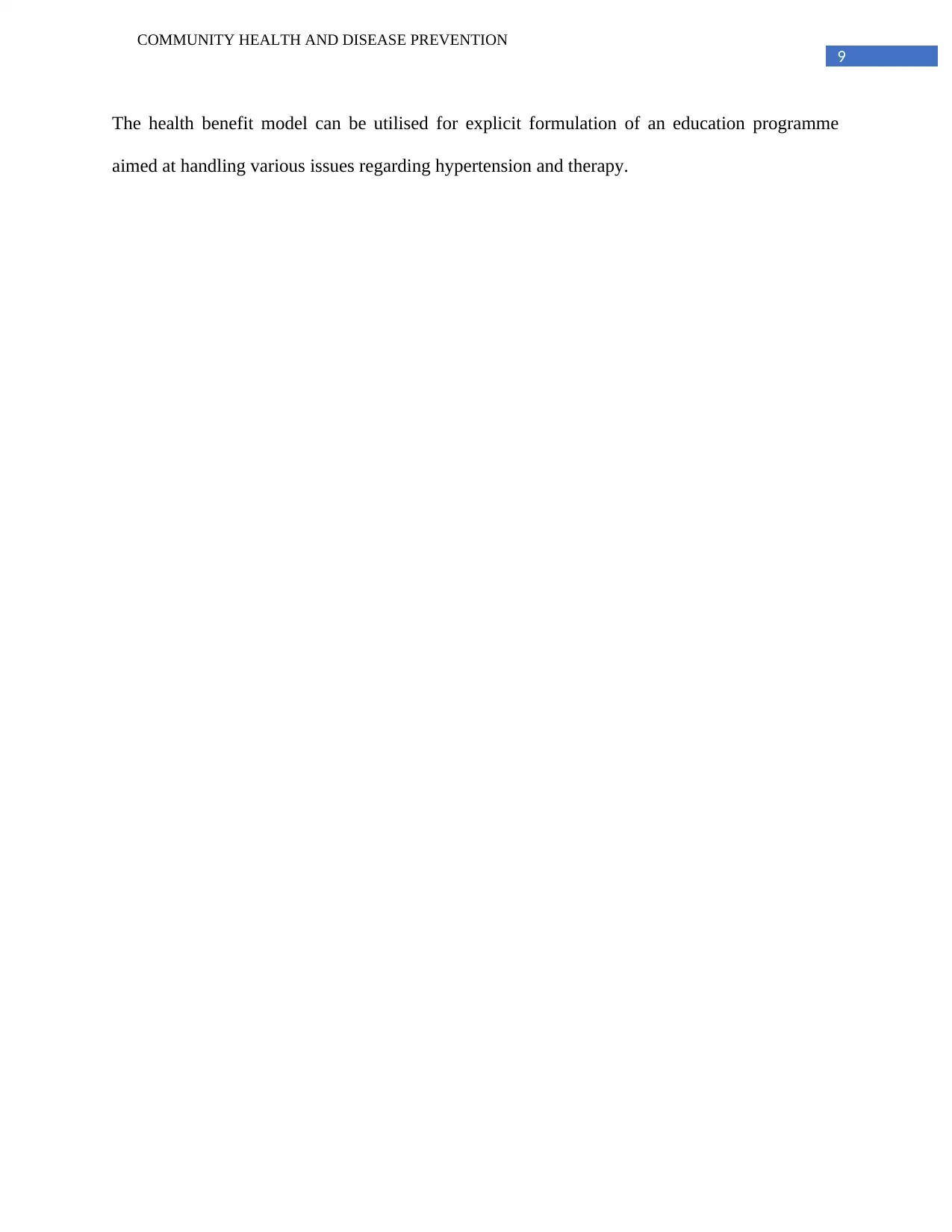
9
COMMUNITY HEALTH AND DISEASE PREVENTION
The health benefit model can be utilised for explicit formulation of an education programme
aimed at handling various issues regarding hypertension and therapy.
COMMUNITY HEALTH AND DISEASE PREVENTION
The health benefit model can be utilised for explicit formulation of an education programme
aimed at handling various issues regarding hypertension and therapy.
⊘ This is a preview!⊘
Do you want full access?
Subscribe today to unlock all pages.

Trusted by 1+ million students worldwide
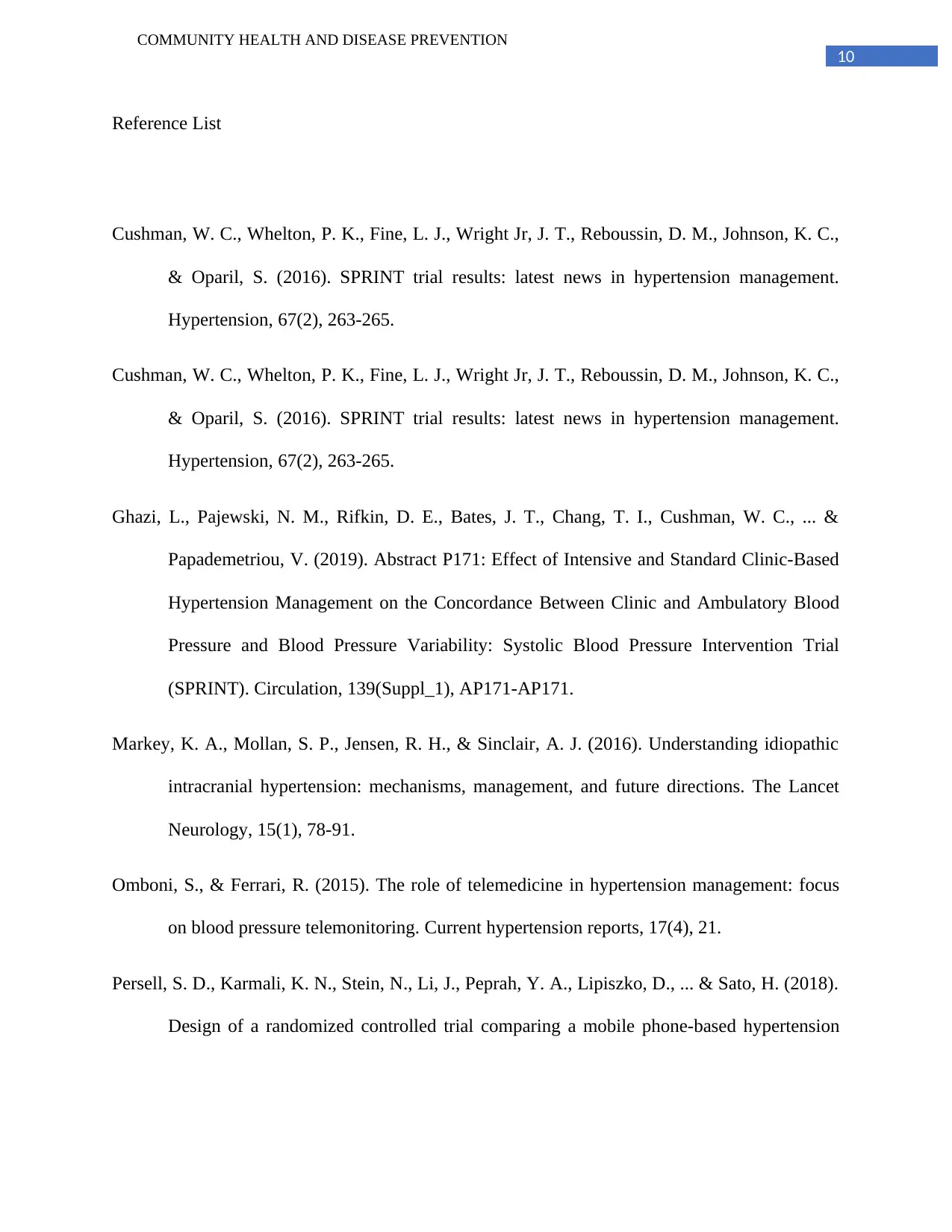
10
COMMUNITY HEALTH AND DISEASE PREVENTION
Reference List
Cushman, W. C., Whelton, P. K., Fine, L. J., Wright Jr, J. T., Reboussin, D. M., Johnson, K. C.,
& Oparil, S. (2016). SPRINT trial results: latest news in hypertension management.
Hypertension, 67(2), 263-265.
Cushman, W. C., Whelton, P. K., Fine, L. J., Wright Jr, J. T., Reboussin, D. M., Johnson, K. C.,
& Oparil, S. (2016). SPRINT trial results: latest news in hypertension management.
Hypertension, 67(2), 263-265.
Ghazi, L., Pajewski, N. M., Rifkin, D. E., Bates, J. T., Chang, T. I., Cushman, W. C., ... &
Papademetriou, V. (2019). Abstract P171: Effect of Intensive and Standard Clinic-Based
Hypertension Management on the Concordance Between Clinic and Ambulatory Blood
Pressure and Blood Pressure Variability: Systolic Blood Pressure Intervention Trial
(SPRINT). Circulation, 139(Suppl_1), AP171-AP171.
Markey, K. A., Mollan, S. P., Jensen, R. H., & Sinclair, A. J. (2016). Understanding idiopathic
intracranial hypertension: mechanisms, management, and future directions. The Lancet
Neurology, 15(1), 78-91.
Omboni, S., & Ferrari, R. (2015). The role of telemedicine in hypertension management: focus
on blood pressure telemonitoring. Current hypertension reports, 17(4), 21.
Persell, S. D., Karmali, K. N., Stein, N., Li, J., Peprah, Y. A., Lipiszko, D., ... & Sato, H. (2018).
Design of a randomized controlled trial comparing a mobile phone-based hypertension
COMMUNITY HEALTH AND DISEASE PREVENTION
Reference List
Cushman, W. C., Whelton, P. K., Fine, L. J., Wright Jr, J. T., Reboussin, D. M., Johnson, K. C.,
& Oparil, S. (2016). SPRINT trial results: latest news in hypertension management.
Hypertension, 67(2), 263-265.
Cushman, W. C., Whelton, P. K., Fine, L. J., Wright Jr, J. T., Reboussin, D. M., Johnson, K. C.,
& Oparil, S. (2016). SPRINT trial results: latest news in hypertension management.
Hypertension, 67(2), 263-265.
Ghazi, L., Pajewski, N. M., Rifkin, D. E., Bates, J. T., Chang, T. I., Cushman, W. C., ... &
Papademetriou, V. (2019). Abstract P171: Effect of Intensive and Standard Clinic-Based
Hypertension Management on the Concordance Between Clinic and Ambulatory Blood
Pressure and Blood Pressure Variability: Systolic Blood Pressure Intervention Trial
(SPRINT). Circulation, 139(Suppl_1), AP171-AP171.
Markey, K. A., Mollan, S. P., Jensen, R. H., & Sinclair, A. J. (2016). Understanding idiopathic
intracranial hypertension: mechanisms, management, and future directions. The Lancet
Neurology, 15(1), 78-91.
Omboni, S., & Ferrari, R. (2015). The role of telemedicine in hypertension management: focus
on blood pressure telemonitoring. Current hypertension reports, 17(4), 21.
Persell, S. D., Karmali, K. N., Stein, N., Li, J., Peprah, Y. A., Lipiszko, D., ... & Sato, H. (2018).
Design of a randomized controlled trial comparing a mobile phone-based hypertension
Paraphrase This Document
Need a fresh take? Get an instant paraphrase of this document with our AI Paraphraser
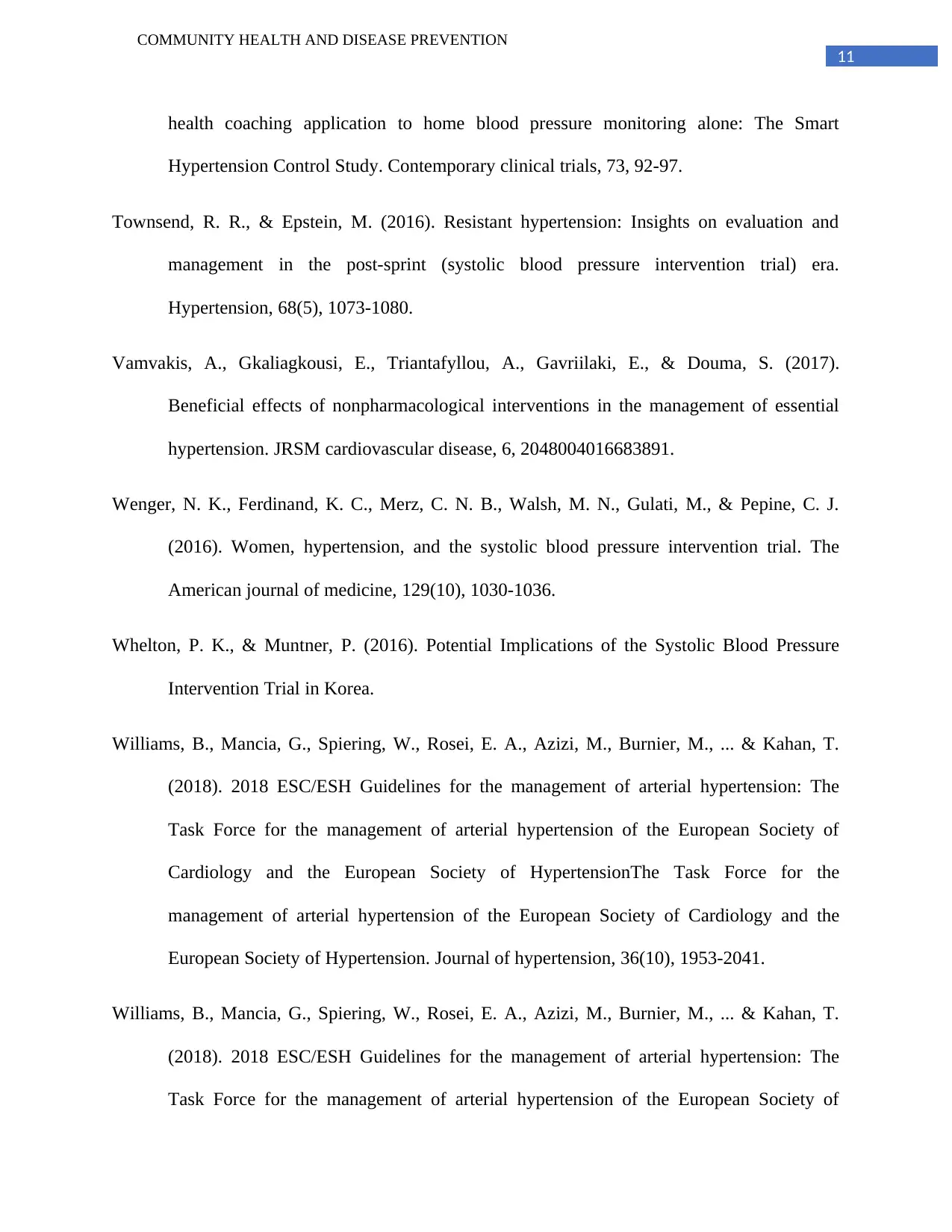
11
COMMUNITY HEALTH AND DISEASE PREVENTION
health coaching application to home blood pressure monitoring alone: The Smart
Hypertension Control Study. Contemporary clinical trials, 73, 92-97.
Townsend, R. R., & Epstein, M. (2016). Resistant hypertension: Insights on evaluation and
management in the post-sprint (systolic blood pressure intervention trial) era.
Hypertension, 68(5), 1073-1080.
Vamvakis, A., Gkaliagkousi, E., Triantafyllou, A., Gavriilaki, E., & Douma, S. (2017).
Beneficial effects of nonpharmacological interventions in the management of essential
hypertension. JRSM cardiovascular disease, 6, 2048004016683891.
Wenger, N. K., Ferdinand, K. C., Merz, C. N. B., Walsh, M. N., Gulati, M., & Pepine, C. J.
(2016). Women, hypertension, and the systolic blood pressure intervention trial. The
American journal of medicine, 129(10), 1030-1036.
Whelton, P. K., & Muntner, P. (2016). Potential Implications of the Systolic Blood Pressure
Intervention Trial in Korea.
Williams, B., Mancia, G., Spiering, W., Rosei, E. A., Azizi, M., Burnier, M., ... & Kahan, T.
(2018). 2018 ESC/ESH Guidelines for the management of arterial hypertension: The
Task Force for the management of arterial hypertension of the European Society of
Cardiology and the European Society of HypertensionThe Task Force for the
management of arterial hypertension of the European Society of Cardiology and the
European Society of Hypertension. Journal of hypertension, 36(10), 1953-2041.
Williams, B., Mancia, G., Spiering, W., Rosei, E. A., Azizi, M., Burnier, M., ... & Kahan, T.
(2018). 2018 ESC/ESH Guidelines for the management of arterial hypertension: The
Task Force for the management of arterial hypertension of the European Society of
COMMUNITY HEALTH AND DISEASE PREVENTION
health coaching application to home blood pressure monitoring alone: The Smart
Hypertension Control Study. Contemporary clinical trials, 73, 92-97.
Townsend, R. R., & Epstein, M. (2016). Resistant hypertension: Insights on evaluation and
management in the post-sprint (systolic blood pressure intervention trial) era.
Hypertension, 68(5), 1073-1080.
Vamvakis, A., Gkaliagkousi, E., Triantafyllou, A., Gavriilaki, E., & Douma, S. (2017).
Beneficial effects of nonpharmacological interventions in the management of essential
hypertension. JRSM cardiovascular disease, 6, 2048004016683891.
Wenger, N. K., Ferdinand, K. C., Merz, C. N. B., Walsh, M. N., Gulati, M., & Pepine, C. J.
(2016). Women, hypertension, and the systolic blood pressure intervention trial. The
American journal of medicine, 129(10), 1030-1036.
Whelton, P. K., & Muntner, P. (2016). Potential Implications of the Systolic Blood Pressure
Intervention Trial in Korea.
Williams, B., Mancia, G., Spiering, W., Rosei, E. A., Azizi, M., Burnier, M., ... & Kahan, T.
(2018). 2018 ESC/ESH Guidelines for the management of arterial hypertension: The
Task Force for the management of arterial hypertension of the European Society of
Cardiology and the European Society of HypertensionThe Task Force for the
management of arterial hypertension of the European Society of Cardiology and the
European Society of Hypertension. Journal of hypertension, 36(10), 1953-2041.
Williams, B., Mancia, G., Spiering, W., Rosei, E. A., Azizi, M., Burnier, M., ... & Kahan, T.
(2018). 2018 ESC/ESH Guidelines for the management of arterial hypertension: The
Task Force for the management of arterial hypertension of the European Society of
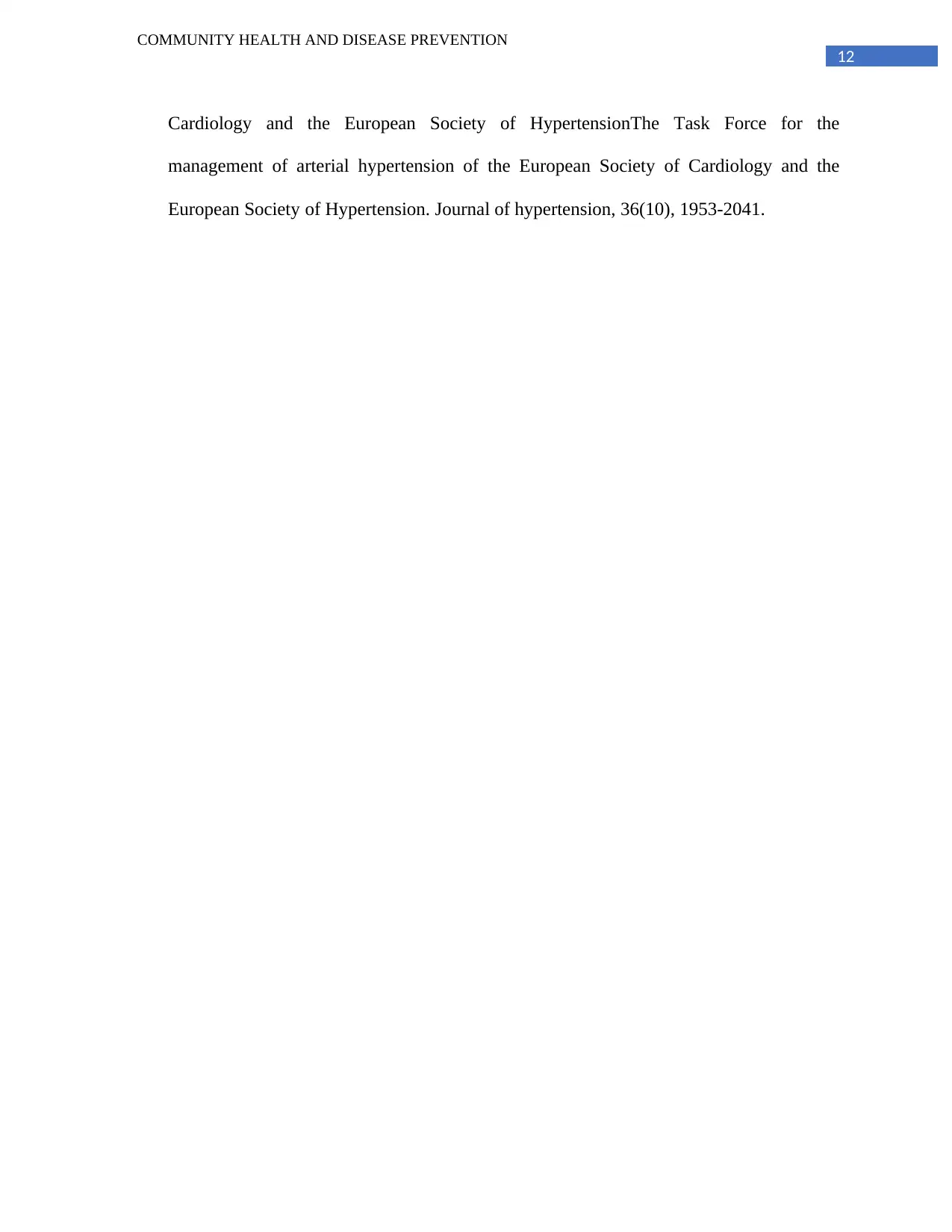
12
COMMUNITY HEALTH AND DISEASE PREVENTION
Cardiology and the European Society of HypertensionThe Task Force for the
management of arterial hypertension of the European Society of Cardiology and the
European Society of Hypertension. Journal of hypertension, 36(10), 1953-2041.
COMMUNITY HEALTH AND DISEASE PREVENTION
Cardiology and the European Society of HypertensionThe Task Force for the
management of arterial hypertension of the European Society of Cardiology and the
European Society of Hypertension. Journal of hypertension, 36(10), 1953-2041.
⊘ This is a preview!⊘
Do you want full access?
Subscribe today to unlock all pages.

Trusted by 1+ million students worldwide
1 out of 12
Related Documents
Your All-in-One AI-Powered Toolkit for Academic Success.
+13062052269
info@desklib.com
Available 24*7 on WhatsApp / Email
![[object Object]](/_next/static/media/star-bottom.7253800d.svg)
Unlock your academic potential
Copyright © 2020–2025 A2Z Services. All Rights Reserved. Developed and managed by ZUCOL.





